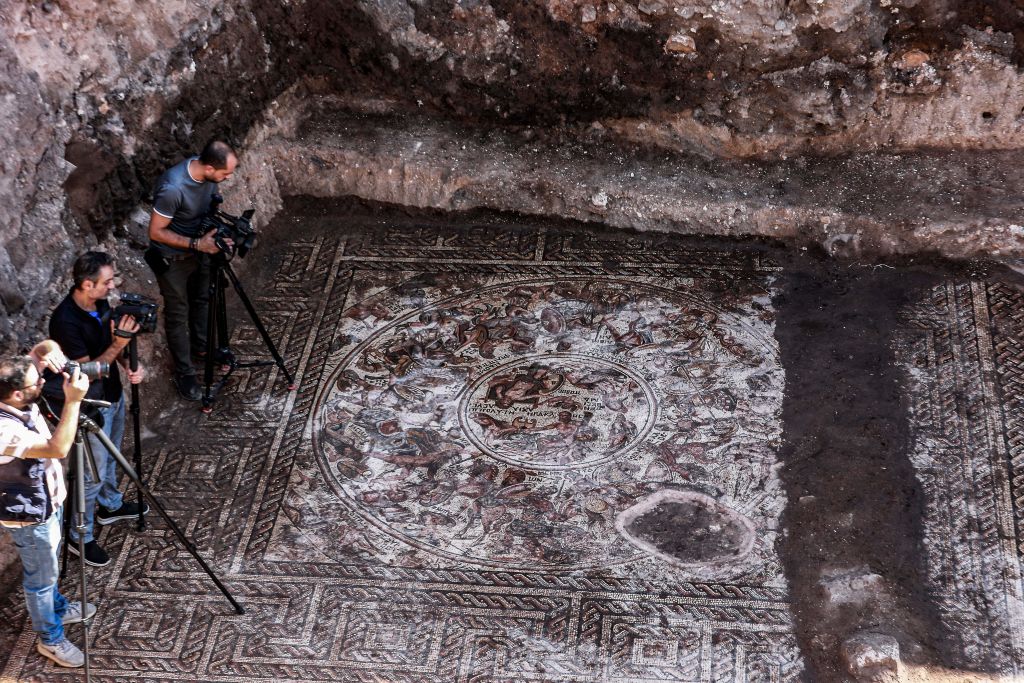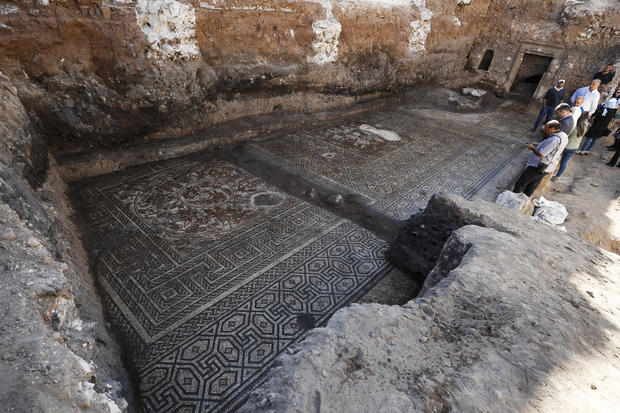No ještě že to těm s prominutím šulinům nevyšlo , to by koupil nějaký zazobaný ropový osel a parkoval by na tom, Bentley. Krásná mozaika 👍👍👍
Huge Roman mosaic saved from being sold off by Islamic State militants
Categories: Nálezy nejenom s detektorem na blízkém východě
A mosaic from the Roman period with scenes from the Trojan War was discovered in Al-Rastan, Syria. Dating from the 4th century, the 20 x 6 m area uncovered is not complete, according to archaeologists - the mosaic seems to continue under neighbouring plots. It is the most significant archaeological discovery in Syria since the conflict began 11 years ago.
The mosaic is composed of two main large figural panels flanked by geometric patterns. One panel depicts the god Neptune surrounded by 50 sea nymphs. The other panel depicts Thetis, the mother of Achilles, along with other Trojan heroes whose names are written in Greek. The work also depicts Amazons, which is very rare in Roman mosaics.
The city of Al-Rastan was founded by Seleucus I. Nicator in the 3rd century BC - then called Arethusa. It was the first capital of the Emesan Kingdom, a Roman client state. Its importance waned when neighbouring Homs (the ancient city of Emesa) became the new capital in the 1st century BC. The area attained worldwide importance in the 3rd century after the marriage of the emperor Septimius Severus to Julia Domna of the royal family of Emesa. In Arethusa lived wealthy people and nobility, who had sufficient financial means to build similarly magnificent mosaics, either in their homes or through sponsorship in public places.
According to experts, it is a miracle that this masterpiece, unparalleled in the country for its size, motifs, quality of workmanship and excellent state of preservation, survived the decades of war virtually unscathed. This is all the more rare given that the mosaic was found in 2017, when ISIS members were in control of the territory. They planned to break the mosaic into parts and sell it off at auction. They even went so far as to post the bid online. Fortunately for the mosaic, the Syrian army recaptured the city in May 2018, and so not only this monument was saved, unlike many others.
The 4th century property was bought by Lebanese and Syrian businessmen from the Nabu Museum and donated to the Syrian state. Archaeologists from the General Directorate of Monuments and Museums were then finally able to uncover the entire mosaic. It is not yet clear what type of building it was. Experts cite a public bath as one of the most likely possibilities.
According to Syrian famous actress and Nabu Museum board member Sulaf Fawakherji, archaeologists hope tothat more land will be bought in Rastan, which is full of monuments and artefacts waiting to be discovered: "There are other buildings, and it's clear that the mosaic is much bigger," Fawkherji told the AP. "Rastan is a historically important city and could be a very important place for tourism as well."
Roman Nemec
Sources: cbsnews.com, artnet.com

4th century mosaic

The mosaic apparently continues under other parts of the building that have not yet been revealed

a unique mosaic measuring 20x6 m

depicts numerous scenes from the Trojan War
The article is included in categories:
- Archive of articles > Archaeology > Finds and rescue research abroad > Nálezy nejenom s detektorem na blízkém východě
Post
V Palmiře mučili zaměstnance muzea aby prozradili kam schovali poklady. A ředitele muzea sťali na náměstí. :(
Jak se někde potloukají psychopati s koránem a kalašnikovem, tam bude brzo velkej problém  Palmira by mohla vyprávět.
Palmira by mohla vyprávět.  Mozaika je nádherná! Ta římská civilizace, to byli sakra dovedové!
Mozaika je nádherná! Ta římská civilizace, to byli sakra dovedové! 
Jo tak takhle by sem si představoval podlahu v koupelně Římané ať byli jakýkoliv měli styl 












